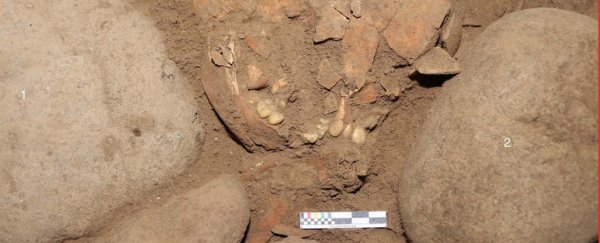The skeleton of an ancient woman, discovered in an Indonesian cave in 2015, appears to have ancestry unlike any other human found to date. Her remains have now provided archaeologists with a rare glimpse of the earliest settlers to leave mainland Asia and begin the journey to New Guinea and Australia.
The roughly 7,200-year-old human, nicknamed Bessé', belonged to a culture of hunter-gatherers known as Toaleans, thought to have been related to the earliest settlers of Indonesia. Up to 65,000 years ago, during the last ice age, the ancestors of Toaleans probably arrived via sea from mainland Asia.
While the Toalean culture never seemed to make it past the Indonesian island of Sulawesi, it seems their relatives continued to push onward.
At least, that's what the inner ear bone of this Toalean woman suggests. Her ancient skull has now provided the first human DNA ever discovered in Wallacea - the ancient island region that once provided a gateway to New Guinea and Australia.
 A map showing the location of Wallacea and where Bessé' was discovered. (Carlhoff et al., Nature, 2021)
A map showing the location of Wallacea and where Bessé' was discovered. (Carlhoff et al., Nature, 2021)
"These seafaring hunter-gatherers were the earliest inhabitants of Sahul, the supercontinent that emerged during the Pleistocene (Ice Age) when global sea levels fell, exposing a land bridge between Australia and New Guinea," explains archaeologist Adam Brumm from Griffith University in Australia.
"To reach Sahul, these pioneering humans made ocean crossings through Wallacea, but little about their journeys is known."
Today, archaeologists argue over where Toaleans first came from and when they arrived in Wallacea. The few tools and artifacts that remain from their long-ago culture seem to be confined to a very small slice of the Indonesian island, which suggests the culture was quite small and isolated.
The skull of Bessé' is one of the few pieces of evidence left. Careful genomic analysis reveals this 17- to 18-year-old Toalean forager has a genetic makeup different to every other early human studied to date. She appears to be some ancient in-between, stranded on an island between two supercontinents.
Bessé' shares roughly half her genetic makeup with modern Indigenous Australians, as well as people from New Guinea and the Western Pacific islands, which suggests her ancestors continued island-hopping past Sulawesi.
Interestingly enough, however, Bessé' shares no apparent ancestry with modern humans living on the island. Researchers think Neolithic farmers from what is now Taiwan began replacing the small Sulawesi culture roughly 3,500 years ago. By the 5th century CE, the society had faded into mere memory.
"The discovery of Bessé' and the implications of her genetic ancestry show just how little we understand about the early human story in our region, and how much more there is left to uncover," says Brumm.
For instance, the Toalean woman appears to have substantial genes of Denisovan ancestry. This provides strong evidence that there was significant cross-over between early modern humans and Denisovans in Asia - similar to the crossover of Neanderthals and modern humans in Europe.
This mixing of genes either occurred prior to the settlement of Wallacea on the mainland or somewhere in the Pacific itself.
Other islands nearby Sulawesi have revealed ancient hunter-gatherers with no apparent Denisovan ancestry, which suggests Sulawesi or some other Wallacean island might have been a crucial place where archaic and modern humans mixed their genes.
"The apparent presence of a long-established population of archaic hominins in southwestern Sulawesi provides a possible source for the introgression event," the authors write.
"Two previous studies have suggested that two deeply divergent Denisovan lineages admixed into the ancestors of Papuan individuals, but our genomic data currently do not have enough resolution to distinguish among one or multiple introgression pulses."
From what we can tell right now, the ancestors in Papua New Guinea don't seem to have as high a percentage of Denisovan-derived genes as the Toalean woman. This suggests that Denisovan genes became diluted the further humans journeyed away from Asia.
But that's just an idea. We need far more genetic evidence before we can begin to properly trace the history of human migration across Asia Pacific.
Bessé', after all, was just one woman.
The study was published in Nature.
